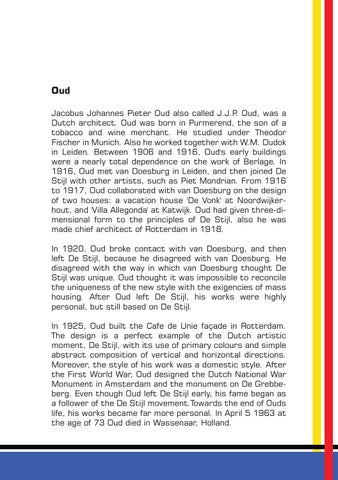Oud Jacobus Johannes Pieter Oud also called J.J.P. Oud, was a Dutch architect. Oud was born in Purmerend, the son of a tobacco and wine merchant. He studied under Theodor Fischer in Munich. Also he worked together with W.M. Dudok in Leiden. Between 1906 and 1916, Oud's early buildings were a nearly total dependence on the work of Berlage. In 1916, Oud met van Doesburg in Leiden, and then joined De Stijl with other artists, such as Piet Mondrian. From 1916 to 1917, Oud collaborated with van Doesburg on the design of two houses: a vacation house 'De Vonk' at Noordwijkerhout, and 'Villa Allegonda' at Katwijk. Oud had given three-dimensional form to the principles of De Stijl, also he was made chief architect of Rotterdam in 1918. In 1920, Oud broke contact with van Doesburg, and then left De Stijl, because he disagreed with van Doesburg. He disagreed with the way in which van Doesburg thought De Stijl was unique. Oud thought it was impossible to reconcile the uniqueness of the new style with the exigencies of mass housing. After Oud left De Stijl, his works were highly personal, but still based on De Stijl. In 1925, Oud built the Cafe de Unie façade in Rotterdam. The design is a perfect example of the Dutch artistic moment, De Stijl, with its use of primary colours and simple abstract composition of vertical and horizontal directions. Moreover, the style of his work was a domestic style. After the First World War, Oud designed the Dutch National War Monument in Amsterdam and the monument on De Grebbeberg. Even though Oud left De Stijl early, his fame began as a follower of the De Stijl movement.Towards the end of Ouds life, his works became far more personal. In April 5 1963 at the age of 73 Oud died in Wassenaar, Holland.
Issuu converts static files into: digital portfolios, online yearbooks, online catalogs, digital photo albums and more. Sign up and create your flipbook.
